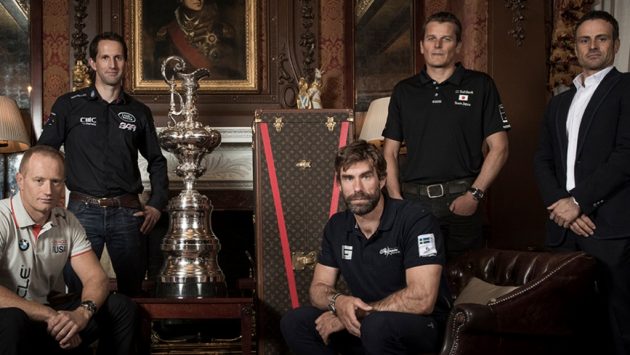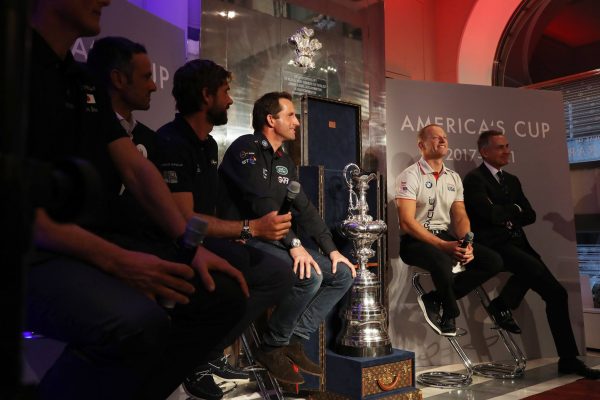America's Cup teams sign agreement for Cup to be raced in new boats every two years - but Emirates Team New Zealand refuses to join up
An agreement has been signed by five of the six America’s Cup teams in one of the biggest changes to the Cup format in its 166-year history. This sets out a new lower-budget America’s Cup Class to sail in both the America’s Cup World Series and the next two Cups.
It will also change the America’s Cup so that it is raced for every two years. The 36th America’s Cup will take place in mid-2019 and the 37th in mid-2021.
The announcement was made today in London, led by Martin Whitmarsh, CEO of Land Rover BAR, who joined the team from a career with F1 team McLaren. He has acted as the chief negotiator between his and the other teams: Cup holders Oracle Team USA, together with Artemis Racing, Groupama Team France and SoftBank Team Japan.
“This agreement provides stability, it gives people an opportunity to plan longer term,” said Whitmarsh. “It will establish a modern sporting technology design challenge within which there will be a much lower entry price. That will in turn encourage more teams to be involved. Ultimately we will reach larger audiences and help inspire more people to go sailing.”
Emirates Team New Zealand was conspicuously absent from today’s press conference. They have not signed up to the framework agreement. The New Zealand team responded to today’s announcement in a Twitter statement, commenting: “Emirates Team NZ believe the future America’s Cup format is to be decided by the Defender and Challenger of Record as it has historically been.”

“They are not here, but they have been informed and kept aware of all developments throughout the agreement and we remain optimistic they will come on board in future,” Whitmarsh said.
He added: “We have expressions of interest from a number of new America’s Cup teams, in large part because of this framework agreement, which allows them to plan participation in future campaigns which vastly increases the knowledge and security about the investment and the sporting environment that they will be competing in.”
The agreement between the five teams was hailed as “a collective vision”. It has been agreed that a new, lower-cost America’s Cup Class design, a foiling multihull, will be created to take part in short course, stadium races. This new class is already being sketched out, and will be a modified but more versatile design of today’s foilers able to race in winds of between 4 and 26 knots. This will replace the current AC45fs as the design raced in the America’s Cup World Series.
The World Series events will count more towards the eventual Cup regatta. Details of how were not announced.
“The ‘turbos’, the test boats, will be used as interim boats, but will be phased out halfway through the next cycle,” Whitmarsh explained. “Costs have been a major focus. We have set US$30-40 million as a target cost per cycle – compared to F1 that is a drop in the ocean.”
The fast-repeat cycle of the new format means that the teams for the 36th Cup will regroup and start again this autumn, providing continuity for teams and the management of the America’s Cup Event Authority which organises it.
The agreement is a breakthrough in that it removes a large part of the advantage which, historically, the defender possessed on winning the Cup. Up until now, the defender could set not just the venue, but the boats to be raced. From now on, the odds cannot unilaterally be skewed in the winner’s favour.
But the agreement does protect the winner’s commercial rights and ability to select a venue. “This agreement respects and upholds all aspects of the Deed of Gift. It has been very carefully created to still allow the wishes of the next Defender to be met,” said Martin Whitmarsh.

The F1 influence
This framework agreement has been a long time in discussion and many people will be surprised that the impetus came from current holders Oracle Team USA. It was an idea of Larry Ellison’s and Russell Coutts’s grand plan originally, but they wanted one of the newer teams to take it forward. That person presented himself in the form of Whitmarsh, a sports management heavyweight who brought with him the credibility of a background in F1.
The consensus was that an agreement needed to be reached before the 35th America’s Cup begins in Bermuda in June, while every team had an incentive to play the next game on a more equal footing. Once it was again in one team’s hands, the process of levelling the playing field would, they reasoned, become much more difficult
The final parts of each team’s differing ideologies have been ironed out since the summer, and the documents to make it a reality have now been signed.
“This is the first time in 166 years that we have got together and we’d like to see twice as many teams in AC36,” said Larry Ellison. “No team can get a competitive advantage and they can plan ahead.”
Russell Coutts said: “There can be more teams, more partners and that’s good for the America’s Cup and for the whole sport in general.”
Sir Ben Ainslie commented: “It’s a pivotal moment in the Cup. We’ve never been able to get an agreement where the teams have come together and said this is where we want the future of the Cup to be, the style of boats we want to race in, the venues and the schedule of the racing.
“So it really does set a fantastic platform for us to get more new teams involved, to get our commercial partners tied in for the future, and the media too, to better understand the challenge of the America’s Cup.”
Watch Ben Ainslie talking to us here:
However, the missing protagonist, Emirates Team New Zealand, is a major part of the Cup and its history. What if they were to win the America’s Cup in Bermuda and, with no part in this agreement, do what they like with it?
What I can tell you is that they have raised no fundamental objections to any aspect. I think they understand that there are other things outside the framework discussions that are probably influencing their decision-making,” Whitmarsh commented. “I am hopeful they will come on board in future.”

Changes in brief:
- The America’s Cup will be on a two-yearly cycle for AC36 (2019) and AC37 (2021).
- The America’s Cup World Series (ACWS) will start, at the election of the defender, as soon as Q4 2017. Venues, sponsors and media partners will be approached over the next six months to secure up to 12 international events over the next two years.
- The first year of the America’s Cup World Series (ACWS) will be raced in AC45F foiling catamarans – the same boats used in America’s Cup World Series (ACWS) in the 35th America’s Cup.
- The second year will see a transition to the America’s Cup Class (ACC) boats, the same technically sophisticated class of boats raced in Bermuda in 2017 (with a slight rule modification to extend the wind range in which they can race to 4 to 26 knots). After this transition to the America’s Cup Class (ACC), the AC45Fs will be retired from the America’s Cup competition and the ACC boats will be the only boats raced.
- The America’s Cup World Series (ACWS) will culminate with a final event at the venue for the next America’s Cup and the final standings from the America’s Cup World Series (ACWS) will be used to qualify teams for the America’s Cup Challenger Playoffs.
- The America’s Cup Challenger Finals and America’s Cup Match will be held in 2019 in a venue selected by the winner of the 35th America’s Cup.
- To reduce costs, teams will not be permitted to build, test or train on AC45 surrogate boats as they have in this cycle of the America’s Cup.
- This above will repeat for AC37, with the exception that all racing will take place in America’s Cup Class (ACC) boats.




